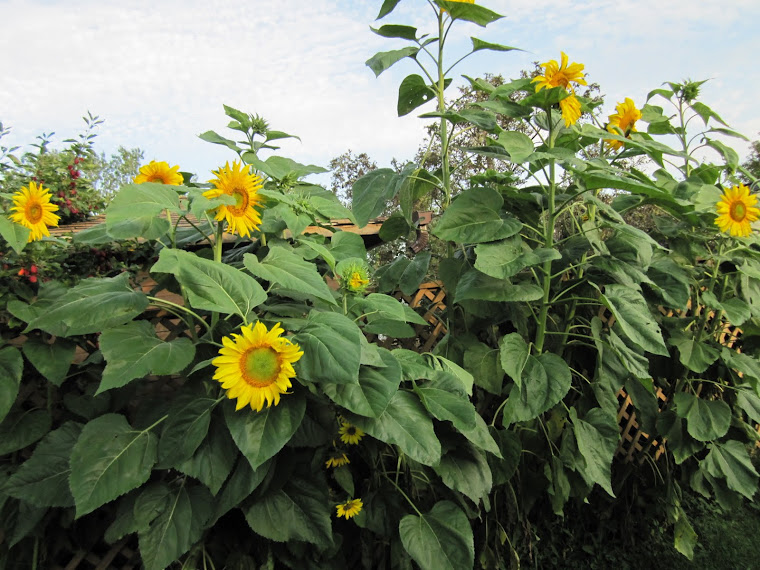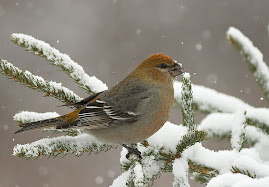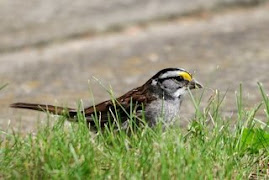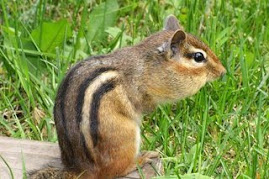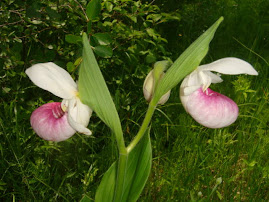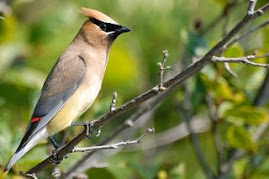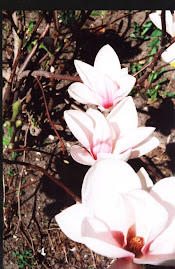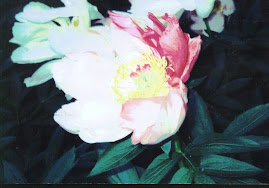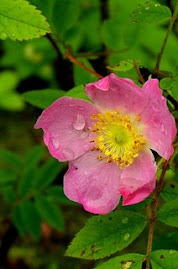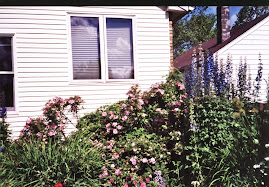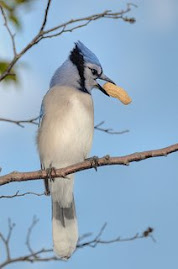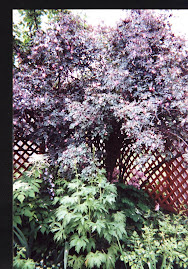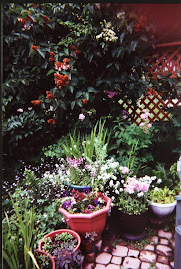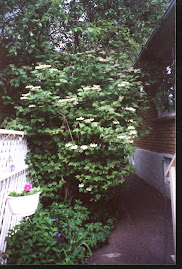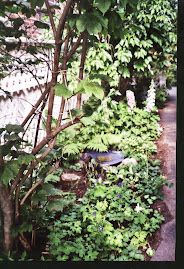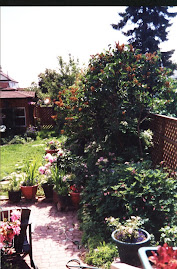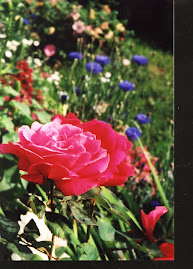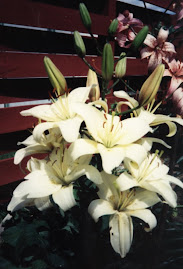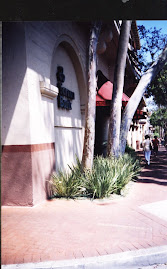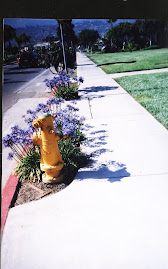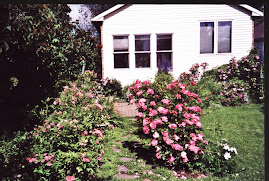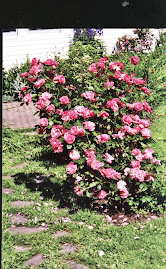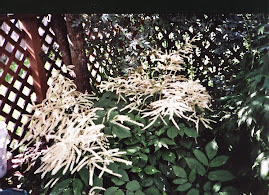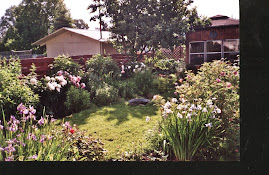The time of peonies and roses is past. Cue the lilies and delphiniums.
Perennials. Shasta daisies, white potentilla and the pink Grutendorst rose with its small carnation-style flowers, add lovely side notes. The monk’s hood will bloom in early August with the phlox. I have pulled all the rue which was loaded with seed. It would take over the garden given half a chance but I love its fluffy mauve blooms. I am still finding the odd forget-me-not plant tucked here and there. It gets pulled and composted too.
Lilies. First come the Asiatics, the hardiest of the lilies. My favourite is the early cream -coloured Roma. I also have some good strong yellow Connecticut Kings, reliable and brassy. I do not grow Oriental lilies because they are not hardy but I have a small collection of trumpets which bloom in August. A few years ago, when a neighbour moved, he gave me some lily plants. The blooms are orange with dark brush marks. I believe they are L.A. hybrids. I was a bit taken aback to have the colour orange in my garden, a bit of a clash - but the lilies are so gorgeous I kept them. Five years ago, I dug a clump of lilies near an abandoned farm field. As far as I can tell, they are Asiatics called Pirate. They are tough red guys. I have several other Asiatic cultivars scattered here and there. You can't have too many lilies.
The day lilies will arrive just as the Asiatics are dying down although the small yellow Stella D’oro has a few blooms already. The golden species day lily finished up two weeks ago.
Roses. The roses were marvelous this year. The Morden Snowberry with its flat floppy white flowers, blooms on. It was not attacked by black spot this year although the other Mordens suffered from this nasty leaf disease. Poor Adelaide Hoodless, a Parkland Rose, which barely grows in the dry conditions of my front yard, managed a few bright red blooms. If I could get this rose untangled from the roots of a nearby maple tree, it would do well. But I cannot dig in the rooty soil and so it struggles on. With Heritage, Parkland and Explorer Roses, location is everything. The Bugnet roses have finished a first flush of bloom and should send up repeat flowers later. The Hansa and The roserie de l'Hay will also put out magenta flowers from time to time. Usually I do not dead head roses. I like to leave the rose hips for the birds in the winter. Besides, it would take hours just to dead head the two big Explorers, Jens Munk and William Baffin.
Annuals. Most of the annuals that I grew in my basement last winter are in flower with the exception of the lavatera which is an August bloomer. Bachelor buttons, schizanthus, cosmos and pansies are all out. Strangely, the schizanthus is purple and not pink as in other times but I remember I bought the seeds from a rack because T&T nursery did not offer them this year.
The nicotania (old fashioned fragrant) which was supposed to grow five feet high has started to produce flowers on plants as short as 12 inches. The catalogue promised “an old fashioned fragrance” but I cannot smell a thing. Long ago the scent was bred out of nicotanias and even out of some varieties of sweet pea. I was hoping to discover the famous nicotania scent mentioned in various novels.
Pots. The lobelia (crystal palace) was doing poorly until I gave it good doses of fertilizer. I usually do not fertilize much with commercial fertilizer but rely on my compost and manure. The tiny yellow marigolds (lemon gem), the geraniums (maverick) and the dianthus (raspberry ripple) are crowding the pots.
Flops. The sweet pea is spindly. The nasturtiums, planted in a small window box, were eaten up by an unknown predator although the few seeds I tucked beside the patio grew into fine plants now creeping across the bricks. The godetia, usually a reliable plant, seems to have disappeared entirely.
Veggies. In the back corner, the few vegetables are doing well. The corn, if not as high as an elephant’s eye, is three feet tall and a good looking cucumber entwines it. Zucchini and squash flouish nearby. The tomatoes (early girl) could be bigger and I blame the cool weather and especially the cool nights.
In my dry front yard, the mullein has exceeded expectations by producing a five foot spire loaded with pure yellow flowers. The non-stop begonias are living up to their name. However I planted several bulbs labeled "white" and I am getting many red and a few yellow blooms but no white. Just another garden surprise like the purple schizanthus. The begonia like their window boxes. They are slower to bloom when planted on the ground.
The garden is thick and bushy this year and the warm weather brings out the laziness of the gardener who has a number of good books on hand as well as a good place to read. The weeds are out there, and I’ll get to them after a rain when they are easy to pull. But now, another cup of tea.
Tip. This is a good time to fertilize perennials. Also annuals in pots can be fertilized up to frost.
Saturday, 26 July 2008
Friday, 25 July 2008
This is the Key to the Kingdom
The Key to the Kingdom, says the old nursery rhyme, is a basket of flowers. And this month, all northwestern Ontario is a breathing basket of wild flowers.
On a recent trip to Rock Island Lodge outside of Wawa I saw sweeps, dreams, charms, floods of flowers along the roadside and in the deepest bush. I do not think, in a long northern life, I have ever experienced a season of such amplitude. I noted with pleasure, the towns of Wawa, Michipicoten and Rossport have not cut down all their wild flowers (as we do in Thunder Bay) but let them bloom in clumps here and there.
Lupines lead the way, swathes of them all along the highway. They were joined by:
· Ox eyed daisies
· Hawk weed (startling reddish orange)
· Mullein, tall fuzzy plants with a yellow stalk of bloom
· Evening primrose (tall with yellow blooms that open in the evening)
· Many varieties of wild pea and vetch
· Bunchberries (four petals, usually in shade)
· Wild strawberry flowers (very late this rainy year)
· Wild roses, some bushes laden
· High bush cranberry (white panicles of flowers)
· Saskatoons, choke cherry and pin cherry
· Wild honeysuckle (a small shrub with yellow flowers)
· Wild asters, white and blue
· Wood lilies, (Always a pleasant surprise)
· Wild iris or blue flags (all along the Michipicoten River)
· Harebells (purple ding-dongs)
· Twin flower (tiny double bells carpet deep bush)
· Queen Ann’s Lace
· Yarrow
· Cow Parsnip (our local giant up to eight feet tall)
· Meadow rue (white lace)
To name just a few. What a cornucopia! Thank you, goddess of the wild places.
Tip. If you visit Rossport, check out the garden at the Serendipity Café
On a recent trip to Rock Island Lodge outside of Wawa I saw sweeps, dreams, charms, floods of flowers along the roadside and in the deepest bush. I do not think, in a long northern life, I have ever experienced a season of such amplitude. I noted with pleasure, the towns of Wawa, Michipicoten and Rossport have not cut down all their wild flowers (as we do in Thunder Bay) but let them bloom in clumps here and there.
Lupines lead the way, swathes of them all along the highway. They were joined by:
· Ox eyed daisies
· Hawk weed (startling reddish orange)
· Mullein, tall fuzzy plants with a yellow stalk of bloom
· Evening primrose (tall with yellow blooms that open in the evening)
· Many varieties of wild pea and vetch
· Bunchberries (four petals, usually in shade)
· Wild strawberry flowers (very late this rainy year)
· Wild roses, some bushes laden
· High bush cranberry (white panicles of flowers)
· Saskatoons, choke cherry and pin cherry
· Wild honeysuckle (a small shrub with yellow flowers)
· Wild asters, white and blue
· Wood lilies, (Always a pleasant surprise)
· Wild iris or blue flags (all along the Michipicoten River)
· Harebells (purple ding-dongs)
· Twin flower (tiny double bells carpet deep bush)
· Queen Ann’s Lace
· Yarrow
· Cow Parsnip (our local giant up to eight feet tall)
· Meadow rue (white lace)
To name just a few. What a cornucopia! Thank you, goddess of the wild places.
Tip. If you visit Rossport, check out the garden at the Serendipity Café
Wednesday, 23 July 2008
WHATEVER COLOURS YOU HAVE IN YOUR MIND
When I first started my garden, I had a vision of white. I wanted a white garden like the famous one in Sissinghurst in England planted by Vita Sackville West. At dusk, she said, the white flowers glow in the lengthening shadows creating a romantic, moonlight ambience.
The White Garden. I bought white peonies, white lilacs, white Sir Galahad Pacific Giant delphiniums and two white apple trees as a start. The white flowers, especially the arabis, did glow like lanterns in the magic hours of the long Thunder Bay twilight. Unfortunately, Vita forgot to mention mosquitoes. They too emerge at dusk, the time when northern gardeners are not strolling about but moving briskly, hands flailing. During the heat of the day when I was enjoying the garden, the white flowers seemed monotonous and insignificant among the greenery. I longed for some drama, some eye candy.
I decide to go colour. However, my work was not lost. The white perennials gave me a good start. White must be part of any garden, not only for its evening glow but because it brightens and sets off other colours. Traditionally, two other colours are added to white to create a palette.
Hot or cool? There are hot gardens and cool gardens. The hot gardens use yellow/orange/white or red/yellow/white or any other hot duo plus white.. I went cool, choosing a pink/blue/white combo. (Some gardeners go so far as to make a distinction between the two shades of pink, the yellow-pink of bleeding heart and the red-pink of peony. It is at this point I think that a garden becomes an exercise in aesthetics rather than a living and changing work of art)
A Walk to Hillcrest. A blue/pink/white bed of annuals planted at Hillcrest Park caught my eye. This park is a good place to muse on colour combinations. It seemed to me that blue/pink/white produced a dainty feminine feeling. I thought the yellow/blue/white grouping was homey and cheerful; the red/blue/white brassy; the orange/yellow/white used too many marigolds. This is all subjective stuff. Colours affect everyone differently.
The Pinks. I added pink peonies, lilies, tulips, roses and a big bleeding heart to my back yard. I learned that there are an unlimited number of pink plants including pink lilacs, pink delphiniums and many, many pink annuals such as lavatera, godetica, and sweet william. One year I went wild with pink pansies. I also learned that many plants sold as pink are really magenta!
The Blues. I planted blue KIng Arthus Pacific Giant delphiniums to go with the white ones as well as blue true geranium and many Siberian iris. I learned that many plants sold as blue are really purple!
White is easy to add to a garden. I added white lilies, sea lavender, campanula and Shasta daisies and many white annuals. Generally, plants sold as white are really white.
I worked on my colour scheme for eight years and I was pleased with the results. But it all but came to a crashing halt one dreadful winter when the garden was destroyed but that is another story.
Tip. Place the lighter coloured flowers at the end of the garden. Put the big white blooms (goats beard, peony, white phlox ) back there where they can be seen from the house.
Wednesday, 9 July 2008
Trees, Trees, Beautiful Trees.
I went into my back lane and my eye was caught by something growing between my compost and my fence. Oh oh! A Manitoba Maple sprout as thick as my little finger. I ran around, dug into the compost and yanked it out. This determined baby tree may be only a few weeks old but it was heading for the sky.
Manitoba Maples are great trees, large, happy Thunder Bay denizens beloved of birds. But, like many trees, they produce millions of seeds. A tiny seedling can bulk out in a few weeks to a thick whippet of a branch that is tough to remove. I have seen a Manitoba Maple take down a fence. A friend had one grow unseen between a fence and a shed and in a season, it was a full blown tree.
All trees shed something – cones, catkins, fluff or seeds. Maple trees send off dry helicopter seeds that can sprout in a garden. I have pulled out many bitsy maples over the years. I gave a three inch sprout to a friend and voila, with good care, a tree in a couple of years.
All gardens, even small ones, need trees. My fav is the mountain ash but I also have a white blooming crab (Dolgo Crab) plus three Brandon pyramid cedars, fine thick trees that create – slowly- a privacy fence. If I had room I would plant the Native Wild Crab Apple for the magnificent blooms. Every spring they bloom along North Rockwood Avenue. The cedar waxwings love them as much as I.
I had an apple tree but I cut it down. This was a Goodland Apple produced by Morden of Manitoba. For the first three years, it produced medium-sized fruit, sweet and good for cooking. But the apples became infected with apple maggot, and unless I wanted to start on a serious schedule of spraying, I would have hundreds of apples that had brown streaks in them and which turned to pulp in a few days. For a few years I tried the various organic remedies but nothing worked. The fly that produces the maggot inhabits the city. Apples in the country are not infected. It is difficult to spray in the city with kids, dogs, and neighbours close by.
I also cut down my Shubert choke cherry. This was a fine tree with nice white spring blooms but it developed an unsightly black lumpy fungus. Slowly the fungus took over the tree. I note that many chokecherry trees around town and in the bush have the thick black growths. The spores are in the air so the best plan is not to plant chokecherries. It's heartbreak to cut down a tree.
The most important thing with trees is to site them properly; preferably on the north side of the garden to block the winter winds but not the sun. Our storms usually come from the northwest and so a few cedars at that corner make a nice wind break.
The Thunder Bayer of old had no air conditioning and did everything to prevent the sun from blasting in the windows. The people dressed in heavy fabrics with multiple petticoats and high collars so they used trees to keep the houses cool. Also, at the turn of the century, upholstery fabrics and wall paper faded badly in sunlight. For these reasons, we see the older houses in town surrounded by very large trees, tall spruce or many birch. The interior of the house was dark but they liked it that way.
Now we want our trees away from the house. It is an expensive proposition to cut down a full sized large tree so the placing of the tree becomes crucial. Smaller trees, mountain ash, nanny berry, the various crab apples, Medora juniper, the Preston lilacs, Morden tower poplar, are favoured now.
Trees have a high mortality rate and need care the first two years. You often see dying baby trees around, so sad. They need water, the right spot, and if they are in an exposed place, a guard to protect them from people, dogs, bicycles etc. Plant the biggest healthiest specimens you can buy (or dig up) to give them a good start.
Manitoba Maples are great trees, large, happy Thunder Bay denizens beloved of birds. But, like many trees, they produce millions of seeds. A tiny seedling can bulk out in a few weeks to a thick whippet of a branch that is tough to remove. I have seen a Manitoba Maple take down a fence. A friend had one grow unseen between a fence and a shed and in a season, it was a full blown tree.
All trees shed something – cones, catkins, fluff or seeds. Maple trees send off dry helicopter seeds that can sprout in a garden. I have pulled out many bitsy maples over the years. I gave a three inch sprout to a friend and voila, with good care, a tree in a couple of years.
All gardens, even small ones, need trees. My fav is the mountain ash but I also have a white blooming crab (Dolgo Crab) plus three Brandon pyramid cedars, fine thick trees that create – slowly- a privacy fence. If I had room I would plant the Native Wild Crab Apple for the magnificent blooms. Every spring they bloom along North Rockwood Avenue. The cedar waxwings love them as much as I.
I had an apple tree but I cut it down. This was a Goodland Apple produced by Morden of Manitoba. For the first three years, it produced medium-sized fruit, sweet and good for cooking. But the apples became infected with apple maggot, and unless I wanted to start on a serious schedule of spraying, I would have hundreds of apples that had brown streaks in them and which turned to pulp in a few days. For a few years I tried the various organic remedies but nothing worked. The fly that produces the maggot inhabits the city. Apples in the country are not infected. It is difficult to spray in the city with kids, dogs, and neighbours close by.
I also cut down my Shubert choke cherry. This was a fine tree with nice white spring blooms but it developed an unsightly black lumpy fungus. Slowly the fungus took over the tree. I note that many chokecherry trees around town and in the bush have the thick black growths. The spores are in the air so the best plan is not to plant chokecherries. It's heartbreak to cut down a tree.
The most important thing with trees is to site them properly; preferably on the north side of the garden to block the winter winds but not the sun. Our storms usually come from the northwest and so a few cedars at that corner make a nice wind break.
The Thunder Bayer of old had no air conditioning and did everything to prevent the sun from blasting in the windows. The people dressed in heavy fabrics with multiple petticoats and high collars so they used trees to keep the houses cool. Also, at the turn of the century, upholstery fabrics and wall paper faded badly in sunlight. For these reasons, we see the older houses in town surrounded by very large trees, tall spruce or many birch. The interior of the house was dark but they liked it that way.
Now we want our trees away from the house. It is an expensive proposition to cut down a full sized large tree so the placing of the tree becomes crucial. Smaller trees, mountain ash, nanny berry, the various crab apples, Medora juniper, the Preston lilacs, Morden tower poplar, are favoured now.
Trees have a high mortality rate and need care the first two years. You often see dying baby trees around, so sad. They need water, the right spot, and if they are in an exposed place, a guard to protect them from people, dogs, bicycles etc. Plant the biggest healthiest specimens you can buy (or dig up) to give them a good start.
Tuesday, 8 July 2008
Peony Petals and Rose in Bloom.
The first peony to release its petals is the big Festiva Maxima, one of the greatest of all peonies, a pure white double peony with carmine flecks on the tips of the petals. This is also the first to bloom closely followed by the pale pink Sarah Bernhardt.
I try to cut the peony heads before the petals fall. One bloom releaeses hundreds of petals which stick to the leaves and turn an unattractive brown. On the ground they create an unsightly brown mat. You can tell when the bloom is finished by gently pulling on a petal. It is comes away without effort the head is ready to cut.
I try to cup the blossom in one hand and snip with the other so as to catch as many petals as possible. After I have cut off the old blooms, I brush and shake the plant to get as many petals as possible off the leaves.
The beautiful rose, Winnipeg Parks, is now in full red bloom. The rose was developed at the Morden research Station in Manitoba. (Worth a visit if you are in the province.) It is one of the few tough Canadian roses with long buds like a hybrid tea (which are not hardy here).
My other Parkland Rose is Adelaide Hoodless, named after the founder of the Women’s Institute. This rose struggles to grow in my dry front yard. I wonder if it will even produce a bloom this year. In a better spot, this is a lovely floriferous red rose.
My two Explorer Roses, Jens Munk and William Baffin have burst into pink bloom. These are big bushes, very thorny and covered with blooms in July. They will both continue to produce flowers up to the frost. But they are tough guys to handle. I have to use goat skin gloves to prune them or tie them up. The smaller Explorer, Henry Hudson, seems to like the dry conditions in the front yard and responds with many double white flowers.
The Bugnet Roses are well on their way. I have two Teresa Bugnets, good sized bushes with pink pompom style flowers and a Marie Bugnet, with white blooms. Both are very hardy and need no winter covering. They are considered heritage roses as is the Hazeldean Rose, now sporting double yellow flowers.
My Morden roses did not do well. Winter killed the Morden Snowberry and the Morden Centenial is struggling.
The good old Hansa rose, a Thunder Bay favourite, will bloom from now to frost.
I try to cut the peony heads before the petals fall. One bloom releaeses hundreds of petals which stick to the leaves and turn an unattractive brown. On the ground they create an unsightly brown mat. You can tell when the bloom is finished by gently pulling on a petal. It is comes away without effort the head is ready to cut.
I try to cup the blossom in one hand and snip with the other so as to catch as many petals as possible. After I have cut off the old blooms, I brush and shake the plant to get as many petals as possible off the leaves.
The beautiful rose, Winnipeg Parks, is now in full red bloom. The rose was developed at the Morden research Station in Manitoba. (Worth a visit if you are in the province.) It is one of the few tough Canadian roses with long buds like a hybrid tea (which are not hardy here).
My other Parkland Rose is Adelaide Hoodless, named after the founder of the Women’s Institute. This rose struggles to grow in my dry front yard. I wonder if it will even produce a bloom this year. In a better spot, this is a lovely floriferous red rose.
My two Explorer Roses, Jens Munk and William Baffin have burst into pink bloom. These are big bushes, very thorny and covered with blooms in July. They will both continue to produce flowers up to the frost. But they are tough guys to handle. I have to use goat skin gloves to prune them or tie them up. The smaller Explorer, Henry Hudson, seems to like the dry conditions in the front yard and responds with many double white flowers.
The Bugnet Roses are well on their way. I have two Teresa Bugnets, good sized bushes with pink pompom style flowers and a Marie Bugnet, with white blooms. Both are very hardy and need no winter covering. They are considered heritage roses as is the Hazeldean Rose, now sporting double yellow flowers.
My Morden roses did not do well. Winter killed the Morden Snowberry and the Morden Centenial is struggling.
The good old Hansa rose, a Thunder Bay favourite, will bloom from now to frost.
COFFEE GROUNDS AT CHAPTERS
Thank You Chapters
Chapters bags and gives away used coffee grounds, great for the soil but excellent to repel slugs around your hostas. I wish Tim’s would give away grounds as well - what a boon for local gardeners, what a great way to recycle.
Sunday, 6 July 2008
I Fought the Worms and the Worms Won
When I came home a week ago from a trip to Colorado, I saw a few leaves on the high bush cranberry were damaged by worms. These are the same critters who lunched there last year, short black guys who hide on the underside of the leaf and eat all but the veins, leaving an openwork lace design behind.
Unfortunately, I did not immediately take action and only a few days later, they had seriously worked over the bush, damaging over half the leaves. These worms do not appear to move much but they certainly got around when I wasn’t looking.
Two days ago I sprayed vigorously but the bush still looks pathetic. These worms also attack apple trees so be prepared. The spray contains Bacillus Thuringiensis or BTK, a bacterium that kills all sorts of caterpillars by infecting their digestive system. The stuff is safe for animals and people although I would not want to test this out. I spray when no one is around and no kids or pets will be visiting. I would not spray near bird baths because this mixture can contaminate water.
I use Safer’s BTK concentrate costing about 11$ for a small bottle which contains enough concentrate to last me for life. I keep it in the fridge as per the directions on the bottle to keep the stuff cool.
This stuff really works but you have to get it under the leaves. Surprisingly, you can’t often see the little pests at first but when you stoop to see under the leaves, you see three or four black stripes per leaf. The spray makes them stop feeding and then later, they fall off, thank heaven.
Last year I vowed I catch these guys early this year before they did much damage. I was not prepared for their lightening-like ability to strip a bush in a day or two. Next year, I will catch these guys before they do much damage, before they do anything at all. I’ll start spraying is I see one hole in a leaf…
Unfortunately, I did not immediately take action and only a few days later, they had seriously worked over the bush, damaging over half the leaves. These worms do not appear to move much but they certainly got around when I wasn’t looking.
Two days ago I sprayed vigorously but the bush still looks pathetic. These worms also attack apple trees so be prepared. The spray contains Bacillus Thuringiensis or BTK, a bacterium that kills all sorts of caterpillars by infecting their digestive system. The stuff is safe for animals and people although I would not want to test this out. I spray when no one is around and no kids or pets will be visiting. I would not spray near bird baths because this mixture can contaminate water.
I use Safer’s BTK concentrate costing about 11$ for a small bottle which contains enough concentrate to last me for life. I keep it in the fridge as per the directions on the bottle to keep the stuff cool.
This stuff really works but you have to get it under the leaves. Surprisingly, you can’t often see the little pests at first but when you stoop to see under the leaves, you see three or four black stripes per leaf. The spray makes them stop feeding and then later, they fall off, thank heaven.
Last year I vowed I catch these guys early this year before they did much damage. I was not prepared for their lightening-like ability to strip a bush in a day or two. Next year, I will catch these guys before they do much damage, before they do anything at all. I’ll start spraying is I see one hole in a leaf…
Friday, 4 July 2008
My List of the Five Worst Garden Pests
1. The mosquito. The worst year ever. The peonies and lilacs send out heavenly scents but I can only smell my perfume, Eau de Off. Sometimes I wear Minuit de Muskol.
2. Cats. They eat the birds, dig holes and use the beds as a litter box. Usually, they are my number 1 pest but, this year, the mosquito surpasses them for pestiness. I have a beautiful Siamese cat hanging out early in the morning and a black and white big kitty comes along from time to time. If I get them, they go to the pound.
3. Wild life. – Bears, deer, skunks, ground hogs and other denizens of Thunder Bay. The magazine Organic Gardener usually contains many letters on how to control these pests. One gardener out in the country leaves a radio playing in the garden day and night. She swears this deters the deer.
4. The slug. I use Safer’s Slug pellets and coffee sprinkled around the target plants such as hostas and pansies.
5. Neighbours who play music so loud you can’t read in the garden. Unfortunately no applications of Off or Slug Pellets work. I usually put on Luciano Pavrotti at top volume. This seems to do the trick.
Hint: if you are driving out to Sleeping Giant Park or Silver Islet, stop at Karen's Kitchen Restaurant and check out her garden. Her rock garden is especially nice. (food is good too).
2. Cats. They eat the birds, dig holes and use the beds as a litter box. Usually, they are my number 1 pest but, this year, the mosquito surpasses them for pestiness. I have a beautiful Siamese cat hanging out early in the morning and a black and white big kitty comes along from time to time. If I get them, they go to the pound.
3. Wild life. – Bears, deer, skunks, ground hogs and other denizens of Thunder Bay. The magazine Organic Gardener usually contains many letters on how to control these pests. One gardener out in the country leaves a radio playing in the garden day and night. She swears this deters the deer.
4. The slug. I use Safer’s Slug pellets and coffee sprinkled around the target plants such as hostas and pansies.
5. Neighbours who play music so loud you can’t read in the garden. Unfortunately no applications of Off or Slug Pellets work. I usually put on Luciano Pavrotti at top volume. This seems to do the trick.
Hint: if you are driving out to Sleeping Giant Park or Silver Islet, stop at Karen's Kitchen Restaurant and check out her garden. Her rock garden is especially nice. (food is good too).
Thursday, 3 July 2008
MARTHA STEWARD DIVIDES AN IRIS
I like Martha and I’ve picked up a lot of good info from the gardening portion of her show. However, a few years back, my eyes goggled when she demonstrated dividing an iris.
She put a garden fork under the iris and out it popped. She placed the plant on one side and gently pulled in it into sections using two garden forks. I gave the TV screen a raspberry.
What wussy iris they have in New England!
The Thunder Bay Siberian iris in my garden never let go without a death grip struggle. First you cannot dig them up – don’t even try unless you have a front end loader handy.
To break off a chunk of iris I have used the following: two hefty grandsons, a tough pruning saw, an ax and wedge and, for the Kaministiquisa iris, a chain saw. The process is messy, sweat inducing and full of bad language.
Still and all, they are fabulous garden plants and I have several varieties blooming madly. When the blooms die down, I will martial the troops, have the gin and tonic handy, and charge in to the fray.
She put a garden fork under the iris and out it popped. She placed the plant on one side and gently pulled in it into sections using two garden forks. I gave the TV screen a raspberry.
What wussy iris they have in New England!
The Thunder Bay Siberian iris in my garden never let go without a death grip struggle. First you cannot dig them up – don’t even try unless you have a front end loader handy.
To break off a chunk of iris I have used the following: two hefty grandsons, a tough pruning saw, an ax and wedge and, for the Kaministiquisa iris, a chain saw. The process is messy, sweat inducing and full of bad language.
Still and all, they are fabulous garden plants and I have several varieties blooming madly. When the blooms die down, I will martial the troops, have the gin and tonic handy, and charge in to the fray.
Wednesday, 2 July 2008
Every Seed That Ever There Was
The rain has caused every dormant seed in my soil to leap into life. Plants from the past have popped up, including white pansies I planted three years ago.
I usually get a few forget-me-nots here and there. I like them very much but I try to pull them before they go to seed. This year they are everywhere and have not only set seeds but a second crop of new plants is on the way. Fortunately they are easy to remove.
Lady’s mantle is dotted in every bed when formerly a bit of it grew in one back corner. It is a tall phlox like plant with a pretty mauve flower. It too is easy to remove before it sets seeds. The species clematis against the house has always produced more vines than the supports can carry.. This year they have over reached and moved into the roses as a first step to take over the world. Today I removed armloads of the soft viness with the lovely cup shaped mauve flowers.
Each section of the garden has its resident weeds. Plantain rules the sun garden. This is an interesting plant, originating in Europe, and called “the white man’s foot print” because it has spread all over the world with European travelers. It has medicinal properties. If you get a rash on your hands from stinging nettles or other plant, pick a handful of plantain leaves, crush them with your hands and rub the pulp on the skin. Will it work for poison ivy? I don’t know. But I remember on a canoe trip, walking in a field of ferns and getting a terrible red itch on my legs. Plantain cured it immediately.
Chickweed tries to take over the shed garden. The dandelions in the lawn are getting desperate. Having been chopped down by the mower several times, they are setting their flower heads lower and lower. Who says plants can’t think.
Grass has snuck into the fronds of the iris and into the arabis. It is easy to remove from the arabis because this spreading plant can be folded back and the grass exposed. However, it’s tough to get grass out of iris and the only sure way is to divide the plant.
Meanwhile, while I am fighting the weed battle, the peonies have started to bloom. The Siberian iris - the light blue “Sky Wings,”, the darker “Caesar’s Brother,” and the lovely mauve “Sparlin’ Rosie”- are all out in full fig. The hansa rose is bursting with flowers as is the red leafed rose. The latter has a spicy scent. The two large Preston lilacs are covered with flowers as is the white Mrs. Casmir Perrier, a double French.
Tip: Now is the time to buy perennials while they are on sale. Consider getting a few pots of lamium “Nancy White,” a variegated leafed plant that looks good along the edges of gardens in partial shade.
I usually get a few forget-me-nots here and there. I like them very much but I try to pull them before they go to seed. This year they are everywhere and have not only set seeds but a second crop of new plants is on the way. Fortunately they are easy to remove.
Lady’s mantle is dotted in every bed when formerly a bit of it grew in one back corner. It is a tall phlox like plant with a pretty mauve flower. It too is easy to remove before it sets seeds. The species clematis against the house has always produced more vines than the supports can carry.. This year they have over reached and moved into the roses as a first step to take over the world. Today I removed armloads of the soft viness with the lovely cup shaped mauve flowers.
Each section of the garden has its resident weeds. Plantain rules the sun garden. This is an interesting plant, originating in Europe, and called “the white man’s foot print” because it has spread all over the world with European travelers. It has medicinal properties. If you get a rash on your hands from stinging nettles or other plant, pick a handful of plantain leaves, crush them with your hands and rub the pulp on the skin. Will it work for poison ivy? I don’t know. But I remember on a canoe trip, walking in a field of ferns and getting a terrible red itch on my legs. Plantain cured it immediately.
Chickweed tries to take over the shed garden. The dandelions in the lawn are getting desperate. Having been chopped down by the mower several times, they are setting their flower heads lower and lower. Who says plants can’t think.
Grass has snuck into the fronds of the iris and into the arabis. It is easy to remove from the arabis because this spreading plant can be folded back and the grass exposed. However, it’s tough to get grass out of iris and the only sure way is to divide the plant.
Meanwhile, while I am fighting the weed battle, the peonies have started to bloom. The Siberian iris - the light blue “Sky Wings,”, the darker “Caesar’s Brother,” and the lovely mauve “Sparlin’ Rosie”- are all out in full fig. The hansa rose is bursting with flowers as is the red leafed rose. The latter has a spicy scent. The two large Preston lilacs are covered with flowers as is the white Mrs. Casmir Perrier, a double French.
Tip: Now is the time to buy perennials while they are on sale. Consider getting a few pots of lamium “Nancy White,” a variegated leafed plant that looks good along the edges of gardens in partial shade.
Tuesday, 1 July 2008
What’s Growing on in My Garden?
The abundant rain has acted like athletic steroids on my perennials. The golden species day lily has expanded so widely it has wiped out a small Japanese peony and a few annuals. Note: next year get a cage on the thing early. Instead, last night, I tried to tie it to a stake.
The ferns in the shade garden, usually about knee high, are, this year, waist high. They look lovely, like a rain forest.
The high bush cranberry, which is trained to arch over the side path, has burst all bounds and now blocks the way. I am not sure it it can be tied up or needs to be pruned.
The caragana hedge is turning into a row of caragana trees. Trimming needed at once.
The bleeding heart added a foot in diameter and covered the daphne bush and two hostas. Since it has finished blooming, it will be brutally reduced.
The Siberian irises are mega size. If there is any garden task I hate, it is dividing Siberian iris. But I will do it after it has bloomed. The only thing to do now is remove the annuals they are smothering and plant them in blank spaces.
The arabis, the most lovely of all creeping plants, is creeping everywhere it can.
Other surprises. The giant hosta is now the monstrous hosta.. The skimpy astilbe has added girth. The peonies are tall, most close to five feet. The mullein has become, against all expectations, a bushy, lovely plant. A Morden Sunrise rose, given up as winter kill three weeks ago, has put on leaves. The Morden monarda is running wild and last year’s seeds are sprouting in various places. Last year I planted one spurge and now a second large plant has appeared five feet away. A tiny red leaf rose sprout has shot up three feet. I saw a garden yesterday where the shasta daisies are making a break for the hills.
However, the rain also created standing puddles on the edges of the beds here and there. The water wiped out a few nicotania and other annuals. I like to have a nice clean cut and a little trench between the beds and the lawn but the water destroyed my edges. Also, my little plot of dark blue bearded iris was rotted out by the standing water and all that is left are the rotted corms. A loss. The evening stock, just starting out, was also destroyed by rain.
In spite of the wet weather, there is little slug damage but I know they are out there somewhere. Slugs hate coffee - liquid or grounds. I am also putting slug pellets around the hostas as a precaution.
The ferns in the shade garden, usually about knee high, are, this year, waist high. They look lovely, like a rain forest.
The high bush cranberry, which is trained to arch over the side path, has burst all bounds and now blocks the way. I am not sure it it can be tied up or needs to be pruned.
The caragana hedge is turning into a row of caragana trees. Trimming needed at once.
The bleeding heart added a foot in diameter and covered the daphne bush and two hostas. Since it has finished blooming, it will be brutally reduced.
The Siberian irises are mega size. If there is any garden task I hate, it is dividing Siberian iris. But I will do it after it has bloomed. The only thing to do now is remove the annuals they are smothering and plant them in blank spaces.
The arabis, the most lovely of all creeping plants, is creeping everywhere it can.
Other surprises. The giant hosta is now the monstrous hosta.. The skimpy astilbe has added girth. The peonies are tall, most close to five feet. The mullein has become, against all expectations, a bushy, lovely plant. A Morden Sunrise rose, given up as winter kill three weeks ago, has put on leaves. The Morden monarda is running wild and last year’s seeds are sprouting in various places. Last year I planted one spurge and now a second large plant has appeared five feet away. A tiny red leaf rose sprout has shot up three feet. I saw a garden yesterday where the shasta daisies are making a break for the hills.
However, the rain also created standing puddles on the edges of the beds here and there. The water wiped out a few nicotania and other annuals. I like to have a nice clean cut and a little trench between the beds and the lawn but the water destroyed my edges. Also, my little plot of dark blue bearded iris was rotted out by the standing water and all that is left are the rotted corms. A loss. The evening stock, just starting out, was also destroyed by rain.
In spite of the wet weather, there is little slug damage but I know they are out there somewhere. Slugs hate coffee - liquid or grounds. I am also putting slug pellets around the hostas as a precaution.
Subscribe to:
Comments (Atom)

